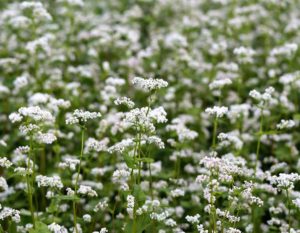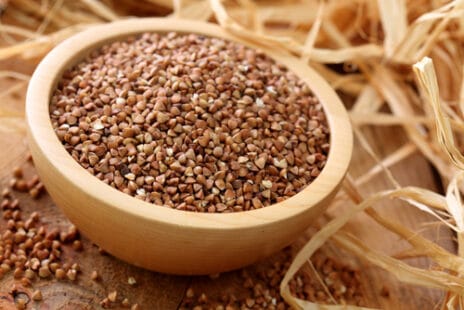Brittany, with its maritime climate, rugged coastline and deep-rooted traditions, is the birthplace of many culinary specialities that have conquered palates the world over.
Buckwheat has a special place among these gustatory treasures. A symbol of Breton identity, this plant with its dark, diamond-shaped seeds has a rich history and invaluable nutritional benefits.
In this article, we invite you to delve into the heart of Breton history and culture by discovering the origins of buckwheat in Brittany, its health benefits, and the various uses of its flour and seeds in cooking.
In these words, we'll also explore how buckwheat has taken root in the Finistère region, becoming an essential part of local gastronomy and a symbol of the perseverance of small-scale producers.

buckwheat flowers
Prepare yourself for a culinary and cultural journey that will
will help you appreciate buckwheat in a whole new light, while inviting you to explore the delights of Finistère, where tradition and innovation come together to create a unique culinary experience.
- The history of buckwheat in Brittany
-
-
Origin of buckwheat in Brittany
-
-
Buckwheat, known as sarrasin in French or gwinizh du in Breton, is much more than just a cereal. Discovered during the Crusades, from which it takes its name, buckwheat has a fascinating history that has deep roots in Brittany. Over the centuries, buckwheat has become an icon of Breton culture, a symbol of perseverance, and a staple of Breton cuisine. regional cuisine.
Buckwheat's journey to Brittany began at the end of the 15th century. It proved to be perfectly suited to the cultivation of newly-cleared moorland, which contributed to its rapid spread in the region. According to popular belief, wheat had been created by God, while had been the work of the Devil. This contrast between the two cereals has left an indelible mark on Breton history and culture.
-
-
-
Evolution of its culture
-
-
Buckwheat is a unique plant, belonging to the Polygonaceae family, like rhubarb and sorrel. One of buckwheat's most striking characteristics was its exemption from tithes, which encouraged its cultivation. For a long time, the grey flour produced from these grains was the cornerstone of the Breton peasant diet. Rudimentary domestic mills were used to produce this precious flour.
Unfortunately, buckwheat is gluten-freeThis made it unsuitable for bread-making, as its dough could not rise under the action of leaven. Until the 19th century, most Bretons ate bread substitutes made from buckwheat flour. Among the most popular delicacies were porridge, crêpes and galettes, as well as bagged far. Although agriculture progressed in the 19th century, allowing rye and wheat to be grown, buckwheat production and its use in domestic cooking continued.
In the 20th century, buckwheat cultivation declined. However, buckwheat became the emblem of Brittany, and its cultivation underwent a revival, marked by the choice of quality and the establishment of labels of origin. Today, buckwheat continues to flourish in Brittany, reminding us all that it's much more than just a cereal - it's a cultural and culinary heritage to be cherished.
-
The Benefits of Buckwheat Flour and Seeds
-
- Why is buckwheat flour good for your health?

A bowl of roasted buckwheat seeds
Buckwheat flour is twice as rich in fibre than soft wheat flour (4.2g/100g versus 2.5g/100g (1)). The fact that it is richer in fibre makes it more satiating. Result: you eat just as much, but you're fuller more quickly and you don't get the munchies between meals.
- Why is buckwheat flour good for your health?
Despite its nickname ofbuckwheat"Buckwheat is not a member of the wheat family. And yes, buckwheat flour does not contain gluten-freewhich makes it suitable even for people with disease celiac.
The gluten Buckwheat is known to be pro-inflammatory, so it could be suitable for an anti-inflammatory diet.The buckwheat flour is richer in nutrients ! In fact, it is rich in iron, magnesium, phosphorus, potassium and are an interesting source of B vitamins.
Buckwheat flour is an interesting source of plant protein. count as follows 11.5 grams of protein per 100 grams of flourcompared with only 9.12 g for wheat flour.
As well as being richer in protein, buckwheat has another undeniable advantage: it contains all the essential amino acids in balanced quantities which makes it a complete" protein - unlike other cereal flours. https://www.lemeunierdesaintthey.bzh/
-
- The health benefits of buckwheat seeds
What is buckwheat made of? ? Buckwheat is a seed in its own right, although most of us consider it to be a gluten-free cereal, just like brown rice or rolled oats. Like other seeds, buckwheat is rich in protein and fibre, but it is unique among the seeds we usually eat in that it is lower in fat and higher in starch. https://grainedebreton.bzh/
The 7 main benefits of buckwheat
- Improves heart health by reducing cholesterol levels and blood pressure.
- Contains disease-fighting antioxidants
- Provides highly digestible proteins
- Its high fibre content is satiating and helps improve digestion.
- Can help prevent diabetes
- Gluten-free and non-allergenic.
- Supplies important vitamins and minerals
-
Uses in cooking
As well as crêpes and galettes, buckwheat can also be found in other Breton dishes, such as slurry buckwheat, a rustic and comforting preparation, as well as far en saca traditional dessert.
More recently, buckwheat has also conquered modern kitchens as a versatile ingredient. Its flour is used to prepare gluten-free pastaThey can also be used in breads, muffins, light pancakes and cakes. Whole buckwheat seeds, toasted or not, add a touch of crunch and flavour to salads, vegetable dishes and breakfast cereals. Buckwheat has become a symbol of Breton culinary creativity, inspiring innovative dishes that celebrate the region's gastronomic heritage while satisfying contemporary palates.
Finally, buckwheat inspires creative chefs to create a multitude of dishes, from starters to desserts. The possibilities are endless: buckwheat risotto with wild mushroomsoriginal salads with buckwheat seeds, fluffy muffins and cakes made with buckwheat flour, and many other culinary innovations.
By adapting to modern cuisine, buckwheat perpetuates its role as an ambassador for Brittany and Finistère in today's gastronomic world.
-
Conclusion: An invitation to discover the delights of buckwheat in Finistère
BuckwheatCorn, this treasure of Brittany with its rich history and culinary versatility, is not a cereal. It bears witness to a history that spans centuries, a history that has shaped the region's culinary identity. Rooted in Breton traditions, buckwheat is also an inexhaustible source of inspiration for modern cooking.
Now that you've plunged into the heart of this story, discovering how buckwheat first appeared in Brittany at the end of the 15th century. We invite you to go further.
Finistère, a land of character, is full of buckwheat-based specialities well worth exploring.
From the famous buckwheat galette filled with local produce to far en sac, not forgetting the modern and innovative creations of our chefs, Finistère offers a unique and authentic culinary experience. It's a chance to taste of traditional and contemporary flavours, immerse yourself in a rich gastronomic culture and support the local producers who carry on the buckwheat tradition.
So, whether you're a Breton at heart, a curious gourmet or a traveller in search of new discoveries: let yourself be seduced by the delights of buckwheat in Finistère. It's an invitation to savour a gastronomic heritage and create new culinary experiences, while celebrating the perseverance of the small-scale producers who have made this cereal a symbol of the region. Don't miss the chance to taste the very essence of Brittany by sampling buckwheat-based specialities, and let your taste buds guide you on this exciting gastronomic adventure.
Explore Finistère, discover buckwheat, and let yourself be carried away by an unforgettable culinary experience, rooted in the Breton terroir and looking to the future.
https://www.lokornmad.bzh/boutique/boissons/thes-et-tisanes/sobacha-200g/